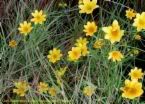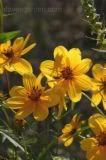

Scientific Name
Bidens aristosa
Uses of Bearded Beggarticks: Landscaping, Medicinal, Culinary, etc...
This plant is used mainly for landscape beautification. It has potential for use in cultivated, garden situations, in naturalized prairie or meadow plantings, and along roadsides.
General Characteristics
Bur marigold is an upright annual herb (1-5 feet tall) with a tap root. The alternate leaves are pinnately or bipinnately dissected, with each segment lanceolate and toothed or lobed on the margin. Plants produce numerous solitary flower heads held on long stalks from September to October; each head is 1-2 inches across and bright yellow with a yellow center. Seeds are dark brown, flattened, and have two prongs that project from one end.
Required Growing Conditions
Bur marigold grows and flowers best in full sun, but is also adapted to partial shade. Plants are often found growing in open shade along the edge of a woodland. It is adapted to most soil types, except for very sandy soils. Natural stands are generally found on moist sites such as in ditches, marshes, and wet meadows.
Bur marigold is distributed throughout the eastern and midwest United States.
Cultivation and Care
Seed should be planted from August to October. The seed will not germinate until the following spring, but it requires exposure to cool, moist conditions during the winter. A firm seedbed is required. Bur marigold germinates best on a clean tilled site that has been firmed with a roller or finishing harrow before planting. Seed can also be planted into a closely mowed, chemically-killed, or burned sod area with a light disking or harrowing that scratches the soil surface. A thick layer of plant residue on the soil surface can interfere with seed germination. Broadcast or shallowly drill 4-6 grams seed per 100 square feet (4-6 lb/acre). Planting depth should range from at the surface to one-quarter of an inch deep. Cultipacking after planting will ensure good seed to soil contact.
General Upkeep and Control
Apply fertilizer according to soil test recommendations. If not available, a rate of 3.5-5.5 oz per 100 square feet (100-150 lb/acre) of 13-13-13 should be applied after the seedlings are established and annually thereafter. Natural or planted stands of bur marigold usually reseed heavily for two to three years but will gradually decline without maintenance. A light to medium disking will help control perennial weeds and promote bur marigold germination. Disking should be done in mid to late November. If necessary, plants can be mowed in the spring before stem elongation begins in April. Stands that are not disked should not be mowed again until after seed set in early November.





0 comments: